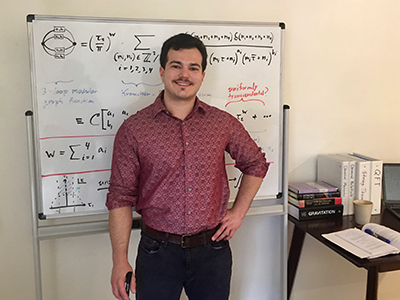
Like most people, Nick Geiser uses Wikipedia every day. As a PhD candidate in theoretical physics at the University of California, Los Angeles, Nick studies string theory and uses mathematics to solve problems in quantum gravity. Outside of research, he works with a variety of organizations to support under-represented minority groups in STEM fields.
When he first saw information about an American Physical Society (APS) Wiki Scientists course, where participants would learn to edit Wikipedia with instruction from Wiki Education, Nick was intrigued, but work and other distractions kept him from applying.
“A few months after that, I read an article about the course itself and the experiences of the Wiki Scientists who took it. I then enthusiastically signed up for the latest iteration of the course and received a scholarship from the APS to attend,” he says. “I specifically wanted to learn how to edit Wikipedia and to spend time improving the biographical pages for minority physicists.”
Nick joined other APS members in a six-week course over Zoom, led by Wiki Education’s Will Kent. As a scientific researcher, Nick says he was familiar with technical writing, but the idea of editing Wikipedia was still daunting to him.
“The weekly meetings and homework assignments were a perfect format to learn the particular skills of editing Wikipedia that I might have never learned on my own,” he says. “Frankly, Wikipedia is overwhelming, and Will broke things down so that I could learn the ropes in manageable steps.”
Following those steps led Nick to improve the biography of Argentine theoretical physicist Miguel Ángel Virasoro, whose work laid the mathematical groundwork for Nick’s field. The article was a stub, meaning it was comprised of a handful of sentences but lacked detail.
“I am also Latino, so I found Virasoro as a fitting first subject for my Wikipedia journey,” Nick explains. “Through writing this article, I learned that a prominent Argentine philosopher with the same name was the father of the physicist Virasoro, but there was no reference to this connection on English language Wikipedia! I disambiguated the two Wikipedia pages and added the fact that they were father and son. I was incredibly surprised that such an important fact was missing from the two Wikipedia pages, and I was happy to have added that particular bit of information.”
Having learned to edit Wikipedia through this course, Nick plans to keep contributing content. He loves how focused he becomes when editing Wikipedia — to the detriment of his other projects, a statement many Wikipedians all over the world can identify with. In the future, he plans to both improve biographies of under-represented physicists as well as regularly editing more technical articles he’s engaging with as part of his own research.
“Improving the open-access reservoir of knowledge on Wikipedia will now be part of my regular work as an academic,” Nick says. “I think all academics, including physicists, should learn the basics of editing Wikipedia. We all write academic papers which may be read by only a few other researchers. Wikipedia articles, however, may be read by millions of people. Just a few hours of edits can tangibly improve a primary source of information for much of the globe.”
“Moreover, STEM in particular has real problems of representation, and improving the biographical articles on Wikipedia for under-represented minority scientists can help turn the tide,” he adds. “Aspiring young scientists are influenced by scientists who look like them, and the biographies of these scientists will not write themselves.”
Image credits: Beyond My Ken, CC BY-SA 4.0, via Wikimedia Commons; Quant Mechanic, CC BY-SA 4.0, via Wikimedia Commons
